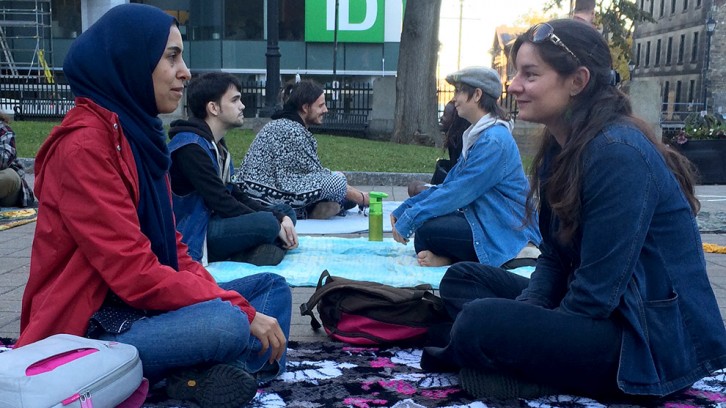Engagement
Experiment encourages strangers to discover the power of eye contact
More than 50 people participated in an eye contact experiment aimed to strengthen bonds between strangers

caption
Participants formed connections in the experiment.
caption
Participants formed connections in the experiment.Everyday we interact with people. We talk, we work, we yell, we laugh.
But in this fast-paced and technology-driven world, do we ever really take the time to look at and understand others? A group of open-minded people tried to find out last night with a public experiment.
The organizers attempted to form connections between strangers — simply by having them look into each other’s eyes for one minute.
“I chose to [hold] this experiment because I’ve had moments of sharing eye contact with people that have led to deep-felt understandings: of myself, of them, of what it is to be human,” said co-organizer Beaky MacLean, a registered massage therapist.
In an attempt to “give people the opportunity to learn for themselves the impact [eye contact] can have,” MacLean, along with holistic healer Michael Cheney, held the experiment at the Grand Parade.
The experiment was part of The World’s Biggest Eye Contact Experiment, which aimed to “rebuild our sense of shared humanity in cities all over the world.”
Created by the social movement Liberators International, the experiment was one of thousands being held in more than 140 cities all over the world last night.
Over the course of three hours, more than 50 people sat on chairs, blankets or stood within circles of rope on the ground and made eye contact with strangers for one minute.
After making eye contact, most people would “chat for about 15 to 20 minutes because they connected in such a short period of time,” said Cheney.
The experiment was open to the public and participants were free to sit with whomever they chose for however long they liked.

caption
The experiment was open to anyone who walked by.Kelsey Merritt participated in the experiment because she had never heard of this type of event before.
She described the experiment as “a little bit weird to begin with.”
“Normally you don’t actually sit down with the intention of actually looking into someone’s eyes,” she said. “It feels more intentional than a lot of other interactions.”
Participant David McInnis described the experiment as “intellectually” interesting.
“When you’re walking down the street and someone actually says ‘Hi,’ to you, it’s actually kind of a nice feeling,” he said. So he found it enjoyable “to just sit here and try to create a connection with strangers without using a lot of words.”
During the experiment many people hugged, held hands and exchanged contact information as they formed what Cheney called “visible and joyous connections.”
He also said the experiment’s aim to bring people closer together caused many people to break into tears.
“I couldn’t count on both hands the [number of] people that were crying. We push aside so many things in favour of technology, in favour of our busy lives, that we sometimes forget what we have at the heart of communication,” he said.
[media-credit id=6 align=”alignnone” width=”726″] [/media-credit]
[/media-credit]

